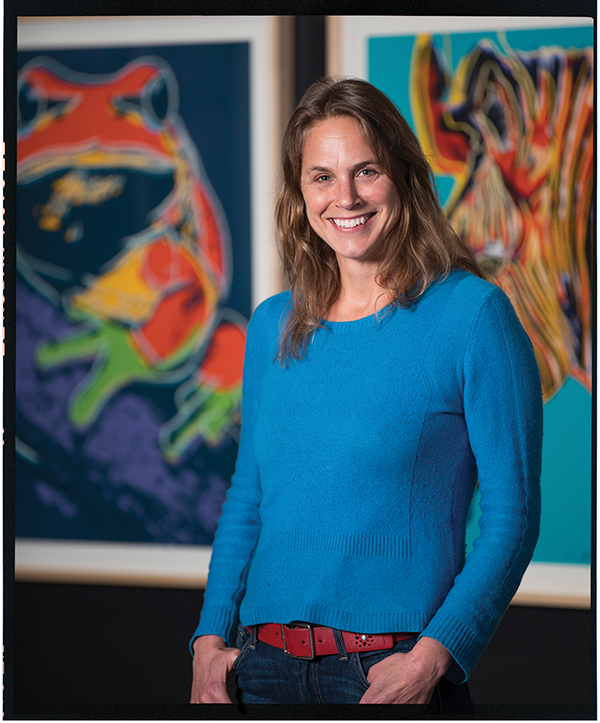
Photo: Josh Franzos
Nicole Heller used to spend her days on hands and knees trying to tease apart the secret world of Argentine ants—an invasive insect that has risen to worldwide prominence thanks to its ability to hitch rides on human trade routes. But after several years debating specialized questions about ant behavior with colleagues, Heller, who spent her formative years in Palo Alto, California, started to yearn for something bigger. “As much as I love ants, I felt like I needed to focus on broader conservation issues,” she says. With a bachelor’s degree from Princeton University and a doctorate from Stanford University, the conservation ecologist scaled up her work to focus on how to make wild areas more resilient to habitat fragmentation and climate change. She worked with climate scientists to develop local climate projections, studied the movements of bobcats and mountain lions in urban areas, negotiated the acquisition of wetlands, and generally sought to better understand what makes ecosystems tick. Now, as she joins the ranks at Carnegie Museum of Natural History, Heller’s sights are set on an even bigger stage: the Anthropocene. Both a cultural term and a proposed name for Earth’s current geological age, many scientists agree that the Anthropocene began sometime in the 1950s when radioactive elements from nuclear bombs started showing up all over the globe, plastics infiltrated the sediment record, and global temperatures began their runaway rise. There are many ways to define the Anthropocene, says Heller, but in the end, it all comes back to us and how we interact with the environment. From ants, to ecosystems, to a hotly contested geologic age, Heller has never shied away from a challenge—a quality that will serve her well as the world’s first curator of the Anthropocene.
How does a natural history museum introduce the Anthropocene?
Carnegie Museum immediately takes a visitor way back in time, which is key to understanding the Anthropocene. You start to learn about geological processes, and the formation of coal, and you enter the world of dinosaurs. The museum already sets you up to think deeply about complex processes and the interrelatedness of ecological systems. So when we introduce the Anthropocene, you’re not suddenly hit over the head with, “Oh, the humans are destroying everything on Earth!” Rather, you understand difficult concepts like geologic change and interrelatedness, and this sets the stage to understand the Anthropocene in a more comprehensive way.
How is the museum addressing issues like climate change, considered to be political by some, without turning people off?
Right now, a lot of environmental topics like climate change are almost unspeakable in communities because they’re politicized, and it’s polite to not say anything about these issues. Our hope is that by the museum taking this on, we make it more public in the community, we open up space for people to talk about it, and we help facilitate the conversation.
Is the goal to present a particular stance on the Anthropocene?
As a museum, we have an obligation to present science. We’re presenting a story that builds on the themes that the museum has always been sharing—that of understanding the diversity of life, of seeing the kinship and the evolution that is the story of life on Earth.
Learning about the impacts humans have on the world can be an emotional experience. Is there room for hope in this story?
This is environmentalism’s Achilles’ heel, right? That it’s a gloom and doom story. But there are lots of positive, hopeful ways to look at this situation. There are constant surprises coming out of ecosystems. Just the other day, scientists reported that they’d found a species of frog that they thought had been extinct due to a fungal infection that’s impacted many frogs in the world. It has had a devastating impact. But in Panama, some scientists just found a population that seems somehow resistant to this fungus. Or you may recall how bald eagles and other birds bounced back after we stopped using the pesticide DDT. These stories have to be part of the narrative. At the same time, one of the challenges is that sometimes the solutions aren’t so easy. Especially with the Anthropocene, where you have this incredibly multifaceted, complex, interrelated, global situation.
What’s the overarching message, then?
It’s a message that shares the real hope that is out there, and gives people the sense that they have agency to affect this problem, that it’s not a lost cause. But not to do it in a way that oversimplifies or trivializes the solutions. I think the history of this museum, the realness of this place, the opportunity it gives you to come and contemplate things deeply is to our advantage.
Our hope is that someone could come here and genuinely mourn and grieve and understand the real losses that we’re facing, but they could simultaneously be inspired by the novelty and the adaptation that is out there on planet Earth. They can see that resilience and then ultimately see the possibility to imagine a different future. Maybe they’ll even
be curious enough to want to keep learning more.
Receive more stories in your email
Sign up